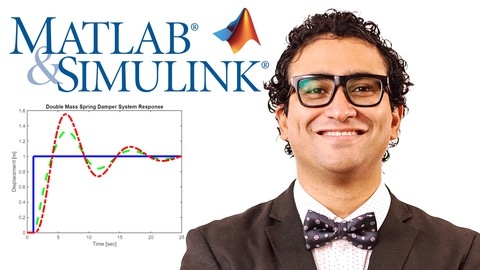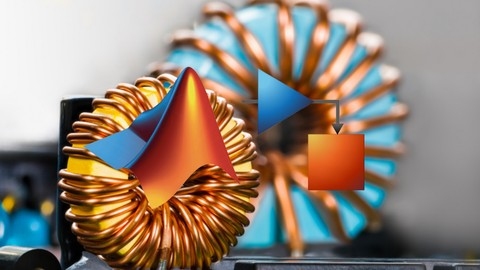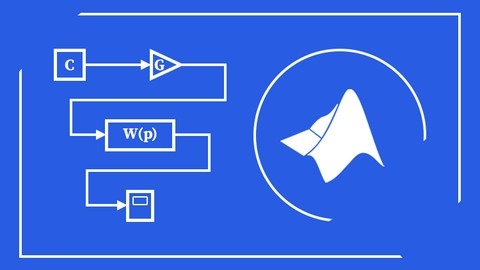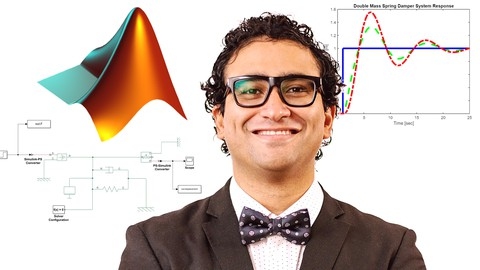Simulink, a graphical programming environment within MATLAB, is a powerful tool for modeling, simulating, and analyzing dynamic systems.
Whether you’re an engineer working on control systems, a researcher exploring new technologies, or a student seeking to deepen your understanding of complex systems, learning Simulink can unlock a world of possibilities.
It allows you to build virtual prototypes of real-world systems, test their behavior under different conditions, and gain valuable insights before implementing them in the real world.
Finding the right Simulink course on Udemy can feel like navigating a maze, with countless options vying for your attention.
You’re looking for a program that’s not only comprehensive but also engaging, taught by experienced instructors, and provides hands-on projects to reinforce your learning.
For the best Simulink course overall on Udemy, we highly recommend MATLAB/SIMULINK Bible | Go From Zero to Hero + ChatGPT!.
This course goes beyond the basics, covering a wide range of applications, from control systems to artificial intelligence, making it ideal for anyone seeking a comprehensive understanding of Simulink’s capabilities.
The course also includes valuable ChatGPT integration, empowering you to leverage this powerful AI tool for code generation, debugging, and optimization.
While this is our top pick, there are other great Simulink courses available on Udemy, each tailored to different learning styles and goals.
Keep reading to explore our recommendations, from beginner-friendly introductions to advanced courses focused on specific applications and industries.
MATLAB/SIMULINK Bible | Go From Zero to Hero + ChatGPT!
This course goes from the fundamentals of MATLAB and Simulink to advanced applications like artificial intelligence and ChatGPT integration.
You’ll start by learning how to generate and display signals like sine waves in MATLAB/Simulink.
This hands-on approach will help you get comfortable with the software right from the start.
The course then dives into more complex projects, such as building mathematical equation systems, simulating mass-spring-damper systems in both time and Laplace domains, and developing battery models.
One of the standout features of this course is its focus on control systems.
You’ll learn how to build and tune PID controllers in Simulink, and then apply them to real-world systems like the mass-spring-damper model.
This practical experience is invaluable for anyone interested in control engineering or robotics.
It also covers artificial intelligence and deep learning using MATLAB/Simulink.
You’ll learn the intuition behind AI, neural networks, and deep learning, and then train your own models to classify diseases.
This section will give you a solid foundation in AI, which is becoming increasingly important in various industries.
Perhaps the most unique aspect of this course is its inclusion of ChatGPT and GPT-4.
You’ll learn how to leverage these powerful language models for tasks like code generation, debugging, optimization, and documentation.
This can be a game-changer for programmers, saving you countless hours of work.
Throughout the course, you’ll work on practical projects that reinforce the concepts you’ve learned.
The assignments and solutions provided will ensure you have a solid understanding of each topic before moving on to the next.
Model Based Development -MBD- For Automotive using Simulink
You’ll start by gaining a foundational understanding of MBD within the ASpice V-model, a crucial framework for developing robust automotive software.
Prepare to dive into the intricacies of the Simulink environment, exploring its powerful interface, solvers, and diverse block libraries.
You’ll learn how to utilize essential blocks such as “Constant”, “Ramp”, “Input”, and “Step” to build foundational models, and then progress to more complex concepts like data types and code generation, which are essential for converting your models into real-world applications.
The course covers a wide range of Simulink block libraries, including those designed for mathematical operations, logic and bitwise operations, and discrete systems.
You’ll learn to implement essential automotive components like Pulse-Width Modulation (PWM) within your models, demonstrating the practical power of Simulink.
You’ll gain valuable hands-on experience through a real-world automotive project: a wiper system.
This project provides a practical context for your learning, allowing you to implement the system using two different approaches and experience the flexibility of Simulink firsthand.
From defining requirements to generating code, you’ll engage with the entire MBD workflow, gaining a holistic understanding of the process.
This course is an excellent stepping stone for anyone seeking to build a successful career in automotive software development.
MATLAB/Simulink - Simulink Course for Electrical Engineering
This course provides a comprehensive introduction to MATLAB and Simulink for electrical engineering applications.
You will start by learning the basics of MATLAB, including its interface, array programming with matrices and vectors, and elementary mathematics functions.
The course then dives into graphics capabilities, covering 2D and 3D plotting, animations, and customizing plots.
You’ll learn programming concepts like scripts, functions, loops, and control structures.
Data import from Excel and text files is also covered.
A major portion is dedicated to Simulink for system simulations.
You’ll learn to model and simulate basic electric circuits, operational amplifiers, first-order circuits, resonant circuits, and power electronics components like rectifiers, choppers, and regulators.
Applications extend to solar and wind energy systems, motors (DC, induction, synchronous), and grid-connected systems.
The symbolic math toolbox is explored for differentiation, integration, limits, algebraic equations, and differential equations.
Advanced topics include PSCAD integration, PID control with tuning, particle swarm optimization, fault detection schemes, masking, and fault analysis of grid-connected PV systems.
Hands-on examples and exercises reinforce the concepts throughout.
A bonus section covers the ETAP software for power system analysis like load flow, short circuit, harmonics, motor starting, and PV system simulation.
Model a Car and Design a PID Controller in MATLAB/SIMULINK
This course takes you on a journey to model a car and design a PID controller using MATLAB/Simulink.
You’ll start by learning the mathematical model behind a car’s dynamics, including the battery performance, motor equivalent, forces at play, and the plant dynamics.
Next, you’ll implement this model in Simulink, setting up the motor transfer function and complete open-loop car dynamics model.
You’ll test this open-loop model to ensure it accurately represents the real-world system.
The course then dives into PID control, guiding you through implementing a PID controller in Simulink and tuning it to achieve the desired performance.
You’ll test the complete closed-loop model with the PID controller and analyze its behavior, including an in-depth look at the derivative gain.
Throughout the course, you’ll work with the Tesla Model S as a real-world example, using its specifications and parameters to build and test your models.
By the end, you’ll have a deep understanding of modeling a car’s dynamics and designing a PID controller to control its motion.
MATLAB/Simulink for Power Electronics Simulations
This comprehensive course equips you with the practical skills to simulate power electronic circuits using MATLAB/Simulink.
You’ll dive straight into the fundamentals, beginning with a solid introduction to the software, including installation, library navigation, and essential components like rectifiers, DC-to-DC converters, and inverters.
The curriculum delves into the intricacies of building models for both single-phase and three-phase systems, covering different rectifier types, including half-wave and full-wave configurations.
You’ll learn to master the creation of duty cycles, a crucial aspect of DC-to-DC converter design, and explore the simulation of buck, boost, and buck-boost converters in Simulink.
The course also provides a thorough understanding of control systems designed specifically for these converters.
The final section focuses on inverters, guiding you through the creation of switch pulses for both single-phase and three-phase inverters, and then simulating their behavior within the Simulink environment.
Model, Simulate and Control a Drone in MATLAB & SIMULINK
You’ll start by delving into the physical and mathematical models that underpin the DJI Mavic Pro, exploring essential aspects like battery performance and the intricacies of DC motors and propellers.
This hands-on approach allows you to gain a deep understanding of how these components contribute to the drone’s overall behavior.
You’ll then transition to building a Simulink model of the drone’s flight dynamics, incorporating both linear and rotational motion.
The course meticulously guides you through modeling disturbances like wind gusts and the actuation system that translates control inputs into motor voltages.
You’ll master the art of implementing various Simulink blocks, connecting them to create a robust model, and debugging it effectively.
And you’ll even discover how to visualize the drone’s 3D motion in MATLAB, adding a visual layer to your understanding.
The course culminates in the implementation of PID control loops for altitude and quadcopter control, offering a practical application of your newfound knowledge.
You’ll learn the art of designing and fine-tuning these controllers to achieve optimal stability and responsiveness for your drone.
MATLAB/SIMULINK Masterclass - From a Beginner to an Expert
You’ll begin by mastering the essential building blocks of Simulink, including sources, sinks, and math functions.
You’ll gain proficiency in manipulating matrices and user-defined functions, essential skills for tackling complex modeling tasks.
The course delves into crucial topics like Laplace Transformation and transfer functions, allowing you to model real-world systems, ranging from mechanical and electrical systems to hydraulic ones.
You’ll gain practical experience by building models of various systems, including a Tank Level Control system, a Mass Spring Damper, and a DC Servo Motor.
The course will introduce you to different types of controllers, such as Proportional (P), Integral (I), and Derivative (D) controllers, and provide you with the skills to implement them effectively in Simulink.
You’ll further refine your modeling expertise by tackling the challenging Quarter Car model, exploring the impact of varying damping coefficients, and gaining a deeper understanding of the complexities present in real-world systems.
Beyond traditional modeling techniques, the course introduces you to State Flow, a powerful tool for creating state machines.
You’ll explore the concept of finite state machines and gain valuable hands-on experience by building real-world applications like a Traffic Light system and a Car Turning Signal system.
The course teaches you how to seamlessly integrate MATLAB and Simulink functions within your state machines, providing you with a comprehensive approach to designing advanced control systems.
The comprehensive curriculum and practical examples make this course an ideal resource for engineers, researchers, and anyone seeking a thorough understanding of Simulink and its applications.
MATLAB/Simulink for Power System Simulations
You’ll begin with the fundamentals, learning how to set up your environment and navigate Simulink’s powerful libraries.
The core of the course lies in building practical Simulink models, encompassing generators, transformers, transmission lines, and power system loads.
You’ll gain hands-on experience with load flow analysis, a crucial aspect of power system design and operation.
The instructor guides you through the step-by-step construction of a test power system model, ensuring you understand how each component interacts.
You’ll then explore generator control strategies, delving into both open-loop and closed-loop methods.
Matlab, Simulink and Stateflow
You’ll embark on a journey that begins with the fundamentals of MATLAB programming, giving you a solid grounding in creating variables, manipulating data types, and working with arrays and matrices.
This strong foundation will serve as your launchpad for understanding how data is handled in the world of Simulink and Stateflow.
Stepping into the world of Simulink, you’ll discover a visual programming environment that utilizes block diagrams to model and simulate dynamic systems.
You’ll get hands-on with the Simulink GUI, building your first model and delving into the vast library of blocks, including continuous, discrete, and logical operations, along with data types, functions, and sources.
This hands-on experience will equip you to build complex models with confidence.
Finally, Stateflow emerges as a powerful tool for designing state machines within Simulink.
You’ll explore the basic elements of Stateflow, like states, transitions, and actions, discovering how they create complex behavior.
You’ll learn to handle different types of states and actions, utilize functions within Stateflow, and build powerful state machines for a range of applications.
You’ll be able to apply your knowledge to real-world problems, building powerful simulations and gaining a deeper understanding of the behavior of dynamic systems.
5 Days of Matlab, Simulink & SimScape + ChatGPT - New!
This “5 Days of MATLAB, Simulink & SimScape + ChatGPT - New!” course offers a comprehensive introduction to simulation and AI using a powerful combination of tools.
You’ll start by diving into the world of physical modeling with SimScape, learning to build simulations of real-world systems like robotic arms and vehicle suspensions.
The course guides you through creating your first models, understanding the problem statement, and simulating the results, providing a solid foundation in this powerful tool.
Next, you’ll delve into time-domain modeling in Simulink, learning to represent systems using free body diagrams and deriving mathematical equations.
You’ll gain practical experience building Simulink models based on these equations and simulating their behavior over time, gaining valuable insights into how systems evolve.
The course then introduces you to the world of transfer functions in MATLAB and Simulink, leveraging Laplace transforms to represent systems in a way that’s ideal for analysis.
You’ll learn how to obtain transfer functions for mechanical systems, build models based on these functions, and simulate them to understand the system’s behavior.
By integrating these different modeling techniques, you’ll gain a comprehensive understanding of how to model and simulate complex systems using a combination of time-domain, s-domain (Laplace transforms), and SimScape approaches.
Finally, you’ll explore the exciting world of AI and Machine Learning with MATLAB and Simulink.
The course introduces concepts like Artificial Neural Networks (ANNs) and Deep Learning (DL), showing you how to import datasets, train a Deep Neural Network to classify disease, and assess the performance of these models.
Adding a powerful element to this already rich curriculum, the course integrates ChatGPT into the learning experience.
You’ll learn how to use this powerful AI tool for tasks like code generation, finding relevant resources, debugging code, optimizing your work, and even adding new features to your code.
This course offers a compelling pathway to mastering simulation and AI tools, equipping you with valuable skills for a wide range of applications.










